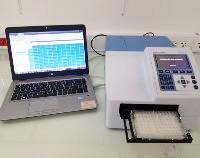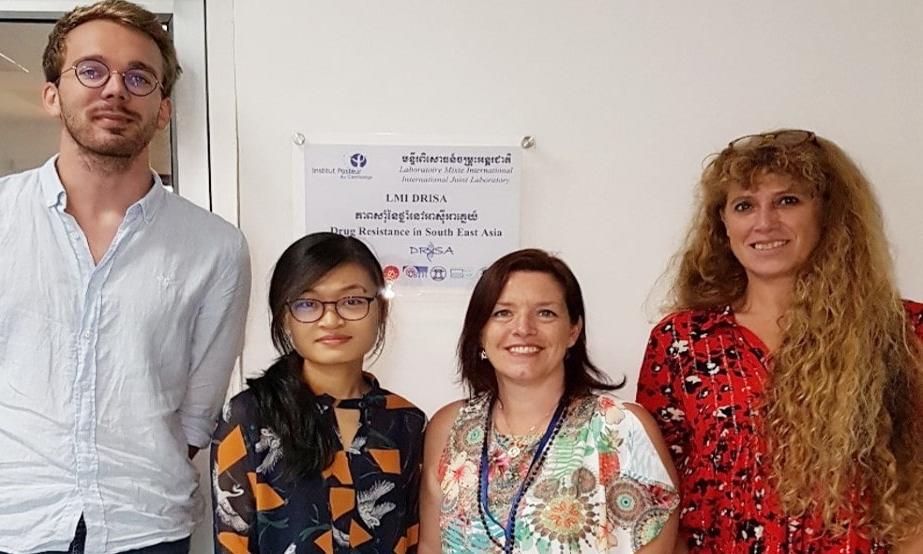Antibiotic resistance poses real problems in human and animal health worldwide, especially with the emergence of more and more resistant strains. South East Asia is the epicenter of many infectious diseases and a major source of resistant and multidrug-resistant bacteria. In this alarming context, controlling their emergence and transmission has become a priority for all public health systems in this region. Antibiotic resistance is probably the most common form of resistance and probably one of the most complex because of the particular characteristics of the bacterial biology. Antibacterial resistance may be encoded by one or more genes. It can occur by mutation and / or selection in a patient, following treatment (secondary resistance) or transmitted between patients (primary resistance). It may be vertically transmitted from one cell to another, by bacterial division or horizontally via a variety of mechanisms (between same species bacteria, or of different species). Besides these complex mechanisms at the cellular level, the spread of resistance occurs between diverse ecosystems characterized by different selection pressures (hospital and community settings, agricultural and urban environments ...). The knowledge of these evolutionary mechanisms is essential for the development of appropriate and efficient strategies to fight and control drug resistance. The purpose of the International Joint Laboratory DRISA is to get an overview of the mechanisms of drug resistance emergence and its transmission at different spatial and temporal scales. This will be achieved by developing complementary approaches involving (1) observational studies in hospital and community settings and in different environments, (2) experimental research, and (3) mathematical modeling. At Institut Pasteur du Cambodge (IPC), the main study concerns the ‘’Genetic determinants and evolution of drug resistance in Mycobacterium tuberculosis in Cambodia, high tuberculosis burden country’’. In 2019, the LMI DRISA has participated to the setup of a Bacteriology Research Laboratory in the Medical laboratory at IPC and in 2020, several studies focusing on relevant bacteria (Burholderia pseudomallei, Escherichia coli, Klebsiella pneumoniae, Acinetobacter baumannii, Staphylococcus aureus, Salmonella spp., Shigella spp.) will be initiated using cellular biology (antimicrobial peptides) and molecular epidemiology.
Project funding: LMI DRISA 2016-2020
[Photo credit: A.L. Bañuls]
ONGOING PROJECTS
-min.jpg)
Collaborators: University of Science and Technology of Hanoï (USTH), Hanoï, Vietnam - Institut Pasteur du Cambodge (IPC), Phnom Penh, Cambodia - Centre d’Infectiologie Christophe Mérieux du Laos (CICML), Vientiane, Laos - Oxford University Clinical Research Unit (OUCRU), Hanoi, Vietnam - Fondation Mérieux/Laboratoire des Pathogènes Émergents (LPE), Lyon, France.
learn more ...

Collaborators: Institut Pasteur du Cambodge (IPC), Cambodia- Battambang Provencial Hospital, Battambang, Cambodia - Calmette Hospital, Phnom Penh, Cambodia
learn more ...
Antibioresistance (ABR) is an increasing Public health concern and threatens decades of infectious disease control efforts. The ARCAHE project aims to explore the circulation of antibiotic resistant bacteria at the interface between humans, animals and the environment in Cambodia. In agreement with the actors of public health, the Institut Pasteur in Cambodia (IPC), the IRD, CIRAD and two major hospitals (Calmette, Phnom Penh and provincial Hospital, Battambang) have gathered around this project to improve control of ABR using ‘’One Health’’ approach. The first specific objective is to estimate the prevalence of antibioresistance in one main hospital of Phnom Penh, Calmette Hospital, and in one provincial hospital, Battambang Provincial Referral Hospital, due to community infections. The second specific objective is to study the circulation of resistant bacteria in the environment (animals, soil, food, water) of patients with resistant bacteria from Battambang hospital. The third objective is to contribute to the development of research capacities and scientific skills on ABR and “One Health” concept.
Funding: Fonds de Solidarité pour les Projets Innovants (FSP-I) (French Ministry of European and Foreign Affairs) with the support from the French Embassy in Cambodia
[Photo credit : ]

Collaborators: Anne-Laure Bañuls (CREES, MIVEGEC, Montpellier), National Center for Tuberculosis and Leprosy Control (CENAT)
learn more ...
This project aims to understand the emergence, spread and evolution of anti-TB drug resistance in M. tuberculosis (MTB) in Cambodia using genetic characterization. 404 MTB isolates, including 115 (28,5%) multi-drug resistant isolates, collected between 2012 and 2017 were characterized for their genotypes and genetic determinants of resistance to first and second-line anti-TB drugs (Publication to be submitted soon).
Funding: LMI DRISA, IRD, French Embassy in Cambodia, Ministry of Education Youth and Sport, NIHE : PHC Lotus Project
[Photo credit: ]

Collaborators: Gauthier Delvallez (Institut Pasteur du Cambodge), Sokleaph Cheng (Institut Pasteur du Cambodge), Sylvain Godreuil (CREES, MIVEGEC, Montpellier), Anne-Laure Bañuls (CREES, MIVEGEC, Montpellier),
learn more ...
Colistin (polymyxin E) is considered a last-line antimicrobial for the treatment of infections in humans caused by multidrug-resistant Enterobacteriaceae. The emergence of colistin resistant strains worldwide leads to therapeutic dead end. The circulation of colistin resistant strains in patients is still poorly known in Cambodia. In this context, we aim to explore colistin resistance among both carbapenemase- and extended-spectrum Beta- Lactamase (ESBL)-producing Escherichia coli (EC) and Klebsiella pneumoniae isolated from humans. The minimum inhibitory concentration (MIC) of Colistin is estimated using broth microdilution (reference method) and molecular determinants are identified for Colistin-resistant bacteria (mcr-like genes).
Preliminary results : Some bacteria resistant to colistin have been identified (2/108 carbapenemase producing Enterobacteriaceae and 4/68 ESBL-producing Enterobacteriaceae) among bacteria isolated from humans between 2016 and 2020 and conserved in the Medical laboratory, IPC. All colistin-resistant EC have the mcr1 gene. Sample screening and molecular identification are ongoing…
Funding: LMI DRISA
Collaborators: Gauthier Delvallez (Institut Pasteur du Cambodge), Sokleaph Cheng (Institut Pasteur du Cambodge), Sylvain Godreuil (CREES, MIVEGEC, Montpellier), Anne-Laure Bañuls (CREES, MIVEGEC, Montpellier),
learn more ...
Burkholderia pseudomallei is a soil dwelling Gram-negative bacterium which causes a fatal human disease, the melioidosis. Melioidosis is a disease of public health importance in highly endemic Southeast Asia and Northern Australia. In Cambodia, culture-confirmed cases have been reported in 23 out of the 25 provinces with an incidence of 28-35 per 100000 children which is probably underestimated.
In this study, we aim to explore the genetic diversity of B. pseudomallei strains in Cambodia. 131 strains identified as Burkholderia by API2One will be study, they were isolated from different hospitals in Phnom-Penh and cryopreserved at the Medical Laboratory (LBM, IPC) between 2016 and 2020. Multilocus sequence typing (MLST) will be used to explore the genetic diversity of the Cambodian B. pseudomallei isolates and the Cambodian data will be compared with the data available from other countries. In addition, Matrix-assisted laser desorption ionization–time-of-flight mass spectrometry (MALDI-ToF MS) will be used to create a homemade spectra database for B. pseudomallei since standard Bruker database cannot differentiate among B. pseudomallei / B. mallei and B. thailandensis.
Funding: LMI DRISA
[Photo credit: ]

Collaborators: Pierre-Olivier Maquart (Institut Pasteur du Cambodge)
learn more ...
The main objective is to determine the population structure of Culex vishnui by using 2 methods: MALDI-TOF for Mosquitos identification and Sequencing for Population Genetics. In a second time, genetic data will be analyzed regarding accessible data of JEV Encephalitis distribution in Cambodia to better understand JEV ecosystems and to determine if a link between mosquito genotypes and epidemiological data exists.
Funding:
[Photo credit: IPC]

Collaborators: Didier Fontenille (MIVEGEC, Montpellier), Pierre-Olivier Maquart (Institut Pasteur du Cambodge)
learn more ...
This study aims to investigate the population genetics structure of Aedes mosquitoes (Aedes aegypti and Aedes albopictus) in Cambodia using Cytochrome Oxidase I (COI) mitochondrial DNA (mtDNA) sequence. The objective of this work is therefore to best characterize mosquito populations, more particularly of the Aedes genus, coming from the Kampong Cham region, as well as close to the borders of adjacent countries.
Funding:
[Photo credit: IPC]
RELEVANT PUBLICATIONS Click here for the full list

Parasitology International
click for abstract ...
A case of cutaneous leishmaniasis was discovered in a 32-year old man with a persistent erythematous plaque. The patient resides in a high altitude (~2000 m above sea level) area that is not endemic for cutaneous leish-maniasis in the Dunai village of Dolpa, Nepal. The patient's lesion was initially misdiagnosed as lupus vulgaris. After response failure to initial treatment, additional testing by histological microscopy revealed the presence ofLeishmaniaamastigotes in tissue from the lesion, and the diagnosis of cutaneous leishmaniasis was confirmed by nested PCR DNA assay of tissue from the lesion, and by a positive rK39 test in blood. Sequencing of the kinetoplast region confirmed the presence ofLeishmania donovani complex. The patient responded well to treatments for cutaneous leishmaniasis and the skin lesions regressed after 6 months. This is the first known case of cutaneous leishmaniasis in a patient in Nepal who resides at high altitude in a non-endemic region. Increasing temperatures in this region of Nepal may be expanding the range of vectors that transmit cutaneous leishmaniasis.
Read more
Antimicrob Agents Chemother
doi: 10.1186/s12879-019-3838-1
click for abstract ...
We detected for the first time blaNDM-5 and blaOXA-181 in Escherichia coli isolates from hospitalized patients and healthy volunteers in Chad. These resistance genes were located on IncX3 and IncF plasmids. Despite the large diversity of E. coli clones, the identified resistant intestinal isolates belonged mainly to the same sequence type.
Read more
BMC Infectious Diseases
doi: 10.1186/s12879-019-3838-1
click for abstract ...
Extended-spectrum ß-lactamase-producing Enterobacteriaceae (ESBL-PE) represent a major problem in the management of nosocomial infections. However, ESBL-PE are not systematically monitored in African countries. The aim of this study was to determine ESBL-PE prevalence in patients from three hospitals in N’Djamena, the capital city of Chad, and to characterize the genetic origin of the observed resistance.
Read more
Parasites & Vectors
doi.org/10.1186/s13071-016-1413-9
click for abstract ...
Although leishmaniases are endemic in 98 countries, they are still considered neglected tropical diseases. Leishmaniases are characterized by the emergence of new virulent and asymptomatic strains of Leishmania spp. and, as a consequence, by a very diverse clinical spectrum. To fight more efficiently these parasites, the mechanisms of host defense and of parasite virulence need to be thoroughly investigated. To this aim, animal models are widely used. However, the results obtained with these models are influenced by several experimental parameters, such as the mouse genetic background, parasite genotype, inoculation route/infection site, parasite dose and phlebotome saliva. In this review, we propose an update on their influence in the two main clinical forms of the disease: cutaneous and visceral leishmaniases.
Read more
DOI: 10.1371/journal.pntd.0004303
click for abstract ...
In the south of France, Leishmania infantum is responsible for numerous cases of canine leishmaniasis (CanL), sporadic cases of human visceral leishmaniasis (VL) and rare cases of cutaneous and muco-cutaneous leishmaniasis (CL and MCL, respectively). Several endemic areas have been clearly identified in the south of France including the Pyrénées-Orientales, Cévennes (CE), Provence (P), Alpes-Maritimes (AM) and Corsica (CO). Within these endemic areas, the two cities of Nice (AM) and Marseille (P), which are located 150 km apart, and their surroundings, concentrate the greatest number of French autochthonous leishmaniasis cases. In this study, 270 L. infantum isolates from an extended time period (1978-2011) from four endemic areas, AM, P, CE and CO, were assessed using Multi-Locus Microsatellite Typing (MLMT). MLMT revealed a total of 121 different genotypes with 91 unique genotypes and 30 repeated genotypes. Substantial genetic diversity was found with a strong genetic differentiation between the Leishmania populations from AM and P. However, exchanges were observed between these two endemic areas in which it seems that strains spread from AM to P. The genetic differentiations in these areas suggest strong epidemiological structuring. A model-based analysis using STRUCTURE revealed two main populations: population A (consisting of samples primarily from the P and AM endemic areas with MON-1 and non-MON-1 strains) and population B consisting of only MON-1 strains essentially from the AM endemic area. For four patients, we observed several isolates from different biological samples which provided insight into disease relapse and re-infection. These findings shed light on the transmission dynamics of parasites in humans. However, further data are required to confirm this hypothesis based on a limited sample set. This study represents the most extensive population analysis of L. infantum strains using MLMT conducted in France
Read more
Trans R Soc Trop Med Hyg
DOI: 10.1016/j.trstmh.2007.09.013
click for abstract ...
In leishmaniasis, cysteine protease b (cpb) multicopy genes have been extensively studied because of their implication in host-parasite interactions. In the Leishmania donovani complex, responsible for visceral leishmaniasis, a set of interesting polymorphisms has been revealed, such as copy sequence or expression according to the parasite's life stage. The single nucleotide polymorphisms observed among these copies could be related to clinical characteristics such as dermotropic versus viscerotropic status. CPB COOH-terminal extension (CTE) is mainly responsible for genetic variability among the copies and appears highly immunogenic. These results suggest that further study of the role of CPBs, especially CTE in clinical outcome, is warranted.
Read morePHOTO GALLERY
Montpellier



